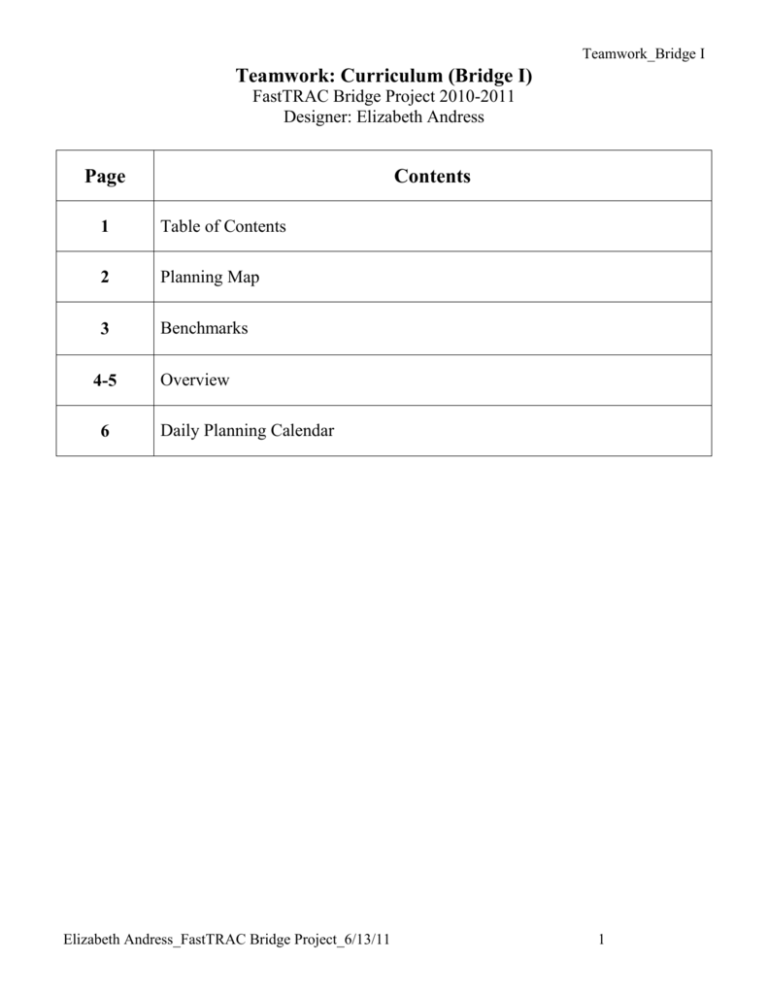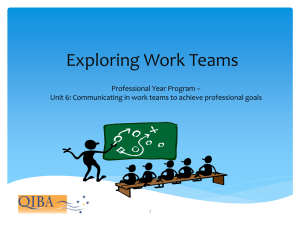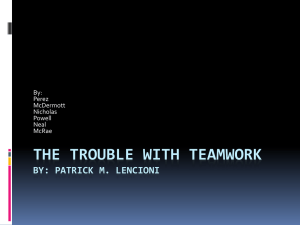Unit Plan
advertisement

Teamwork_Bridge I Teamwork: Curriculum (Bridge I) FastTRAC Bridge Project 2010-2011 Designer: Elizabeth Andress Page Contents 1 Table of Contents 2 Planning Map 3 Benchmarks 4-5 6 Overview Daily Planning Calendar Elizabeth Andress_FastTRAC Bridge Project_6/13/11 1 Teamwork_Bridge I Product-Based Unit Plan Activity Product 2 *My learning styles profile – based on on-line questionnaire Activity Product 3 *My learning styles – reflection notes Activity Product 1 * Language for effective teamwork – tips and card sort Activity Product 1 *Learning Styles worksheet – based on article Section Product 1 *Talking about our learning styles – my learning style, how the info can help me learn better Final Product: *Team “presentation” on one aspect of learning style; and team evaluation of process Section Product 2 *Teamwork evaluation rubric – self and team Activity Product 4 *Critical discussion – connecting learning style to learning environments Activity Product 5 * Activity Product 2 * Guidelines for effective teamwork – per existing knowledge and experience Activity Product 3 * Teamwork on the job – investigation report Activity Product 4 * Activity Product 6 * Elizabeth Andress_FastTRAC Bridge Project_6/13/11 Activity Product 6 * 2 Activity Product 5 * Teamwork_Bridge I Module Benchmarks SCANS Skill Focus: Interpersonal: Works with others – Participates as a member of a team – Contributes to group effort Final Module Product (Description): Team “presentation” on one aspect of learning style; and team evaluation of process Section Product: Learners will produce… Talking about our learning styles – my learning style, how the info can help me learn better Reading *Grammar Focus Read non-fiction article for key information Read personal profile that uses a “dimension” approach Conversation *Grammar Focus Verbally convey information and personal reflections in small and large groups Use construction “I prefer…” Writing Work/Soft Skills *Grammar Focus Write personal Use critical thinking reflections / insights skills to connect from material studied material with self and connections to self Technology Teamwork evaluation rubric – self and team Read select resources and glean teamwork guidelines from them Use grammatical constructions for expressing opinions politely Write guidelines in short phrase form Organize ideas in bubble map format (optional) Use technology to present investigation findings – video, PowerPoint, internet on LCD projector, etc. Elizabeth Andress_FastTRAC Bridge Project_6/13/11 3 State opinions politely but assertively Offer and turn down suggestions respectfully Create and use evaluation rubric for self- and peer evaluation Complete an on-line questionnaire Use an internet search engine to research a topic (FP) Teamwork_Bridge I Learning Module Overview Module Title: Teamwork CASAS or TABE Form/Level: Advanced ESL/Low Intermediate ABE Module Duration: 11 days SCANS Skill Focus: Interpersonal: Works with others – Participates as a member of a team – Contributes to group effort Section Product 1 (S1) Materials Activity Product 1 (S1-A1) Activity Product 2 (S1-A2) Activity Product 3 (S1-A3) Learning Styles – worksheet My Learning Styles – Profile My Learning Styles – Written Learning Styles worksheet (S1Description: Talking about Reflection A1) our learning styles – my Learning Styles and Strategieslearning style, how the info Article (ref.-S1-A1) Activity Product 4 (S1-A4) Activity Product 5 (S1-A5) Activity Product 6 (S1-A6) can help me learn better My Learning Styles-Profile Materials: Teacher notes Critical Discussion – Learning (S1-A2) Styles and Learning Index of Learning Styles Environments Questionnaire (S1-A2) Sample Results (S1-A2) Student computers – to take learning styles questionnaire (S1-A2) My Learning Styles-Reflection (S1-A3) Teacher notes – critical discussion (S1-A4) Section Product 2 (S2) Materials Language for Effective Description: Teamwork Teamwork – worksheets with evaluation rubric – self and card sorts (S2-A1) team Scissors class set (S2-A1) Guidelines for Effective Materials: Teamwork Evaluation teamwork – worksheet, bubble map, sample completed bubble template and example map (S2-A2) Teamwork on the Job – instructions, resource list (S2A3) Elizabeth Andress_FastTRAC Bridge Project_6/13/11 Activity Product 1 (S2-A1) Activity Product 2 (S2-A2) Activity Product 3 (S2-A3) Language for Effective Teamwork – tips and card sorts Guidelines for Effective Teamwork – worksheet and bubble map Teamwork on the Job project and presentation Activity Product 4 (S2-A4) Activity Product 5 (S2-A5) Activity Product 6 (S2-A6) 4 Teamwork_Bridge I Final Product (FP) Materials Team Project on Learning Team “presentation” on Styles – student/team one aspect of learning instructions style; and team evaluation Teamwork Evaluation rubric of process (as created by class in S2) Student computers – to do internet research Materials for team projects – poster board and markers, computers, etc. – as needed Elizabeth Andress_FastTRAC Bridge Project_6/13/11 Final Product Description The final product combines work on learning styles with effective teamwork. The goals of the project are: a) to work effectively with a team on a project; b) to evaluate teamwork; and c) to help others in the class understand one aspect of learning style. Learners look back at their learning style profiles and choose one aspect where they have a clear preference. They form teams of three or more people with a similar preference and work as a team to complete a project, following the guidelines for effective teamwork. They use the internet to research more about the specific learning style preference the team shares; decide how to present the information to the class; prepare and practice their presentation; and present to the class. Finally, they use the teamwork evaluation form from S2 to evaluate their work as a team. The class debriefs the experience together, with focus on effective teamwork – challenges and successes. 5 Teamwork_Bridge I Planning Calendar Hour Plan by Hour 1 Introduce module, target skill areas (benchmarks); S1-A1 – Learning Styles – discussion, reading, worksheet 2 3 4 5 6 7 8 S1-A2 – My learning styles profile – students use computers, complete on-line questionnaire (44 items), print out resulting profile; connect profile back to article S1-A3 (begin) – My Learning styles reflection – students write about each aspect of their learning style and implications S1-A3 (finish) – My Learning styles reflection – students write about each aspect of their learning style and implications S1-A4 – Critical Discussion – teacher leads full group discussion S1 – Talking about Your Learning Style – in small groups S2-A1 – Language for Effective Teamwork – tips, discussion, two card sorts, speaking practice S2-A2 – Guidelines for Effective Teamwork – students write from own experience; class populates bubble map; consider posting large size bubble map in class for on-going reference S2-A3 (begin) – Teamwork on the Job – understand assignment, make plan S2-A3 (continue) – Teamwork on the Job – conduct investigation; prepare findings to share with class S2-A3 (finish) – Teamwork on the Job – present findings to class S2 – Teamwork Evaluation rubric – fill in 10 standards for effective teamwork – will be used to evaluate teamwork in FP FP (begin) – Team Project on Learning Styles – form teams, make team plans, do internet research 9 FP (continue) – Team Project on Learning Styles – finish internet research, choose key info to share, decide how to present information; prepare presentation 10 FP (continue) – Team Project on Learning Styles – prepare and practice presentations; begin team presentations 11 FP (finish) – Team Project on Learning Styles – finish all team presentations; teams evaluate teamwork with S2 rubric; debrief as a class, celebrate success Elizabeth Andress_FastTRAC Bridge Project_6/13/11 6




![Teamwork [doc]](http://s3.studylib.net/store/data/007119492_1-4f52bf0b0aa8b7482c84777d359de0b7-300x300.png)


